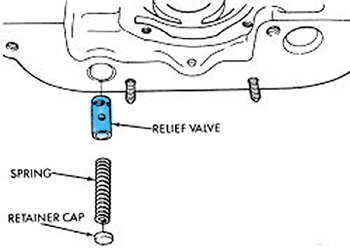There have been reported incidents of stuck oil pressure relief valve assemblies in the chain case cover.
With a stuck oil pressure relief valve, the oil pressure is not regulated as it is supposed to be, resulting in possible low oil pressure and engine damage due to oil starvation.
Note: This bulletin applies to vehicles built prior to Jan. 1, 2002 equipped with a Chrysler 3.3L or 3.8L engine.
When a short-block engine is replaced, replace the chain case cover assembly if any of the following symptoms are present:
• The vehicle exhibited low or no oil pressure
at idle;
• There is metal debris in the oil pan upon removal from engine;
• Main or rod bearing(s) are spun;
• Crankshaft rod or main journals are scored; or
• Intermittent oil light is flashing off and on.
 The purpose of replacing the chain case cover is to prevent damage to a second engine due to a stuck oil pressure relief valve. Before the oil filter adapter is reattached to the new short engine, verify that oil feed and return passages are clear of debris that may hinder oil flow or re-enter the oil pressure relief valve on the new engine.
The purpose of replacing the chain case cover is to prevent damage to a second engine due to a stuck oil pressure relief valve. Before the oil filter adapter is reattached to the new short engine, verify that oil feed and return passages are clear of debris that may hinder oil flow or re-enter the oil pressure relief valve on the new engine.
See Figure 1.
Parts Required:
1 – Timing Chain Case Cover, P/N 05019333AA.
This bulletin supersedes technical service bulletin 09-007-01 dated Aug. 31, 2001, which should be removed from your files.
Some or all of this information was provided by the Automotive Parts Remanufacturers Association (APRA). For more information on technical bulletins available through APRA, call 703-968-2772 or visit www.AutoBulletins.com.













